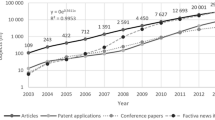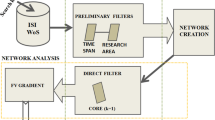Abstract
A case study of an emerging research area is presented dealing with the creation of organic thin film transistors, a subtopic within the general area called “plastic electronics.” The purpose of this case study is to determine the structural properties of the citation network that may be characteristic of the emergence, development, and application or demise of a research area. Research on organic thin film transistors is highly interdisciplinary, involving journals and research groups from physics, chemistry, materials science, and engineering. There is a clear path to industrial applications if certain technical problems can be overcome. Despite the applied nature and potential for patentable inventions, scholarly publications from both academia and industry have continued at a rapid pace through 2007. The question is whether the bibliometric indicators point to a decline in this area due to imminent commercialization or to insurmountable technical problems with these materials.
Similar content being viewed by others
References
Chen, C. (2006), CiteSpace II: Detecting and visualizing emerging trends and transient patterns in scientific literature. Journal of the American Society for Information Science and Technology, 57(3): 359–377.
Collins, G. P. (2004), Next stretch for plastic electronics. Scientific American, 291: 74v81.
Crane, D. (1972), Invisible Colleges Diffusion of Knowledge in Scientific Communities. Chicago, IL, University of Chicago Press.
Dawkins, R. (1976), The Selfish Gene. Oxford, UK: Oxford University Press.
Garfield, E., Pudovkin, A. I., Istomin, V. S. (2003), Why do we need algorithmic historiography? Journal of the American Society for Information Science and Technology, 54(5): 400–412.
Morris, S. A., Yen, G., Wu, Z., Asnake, B. (2003), Timeline visualization of research fronts. Journal of the American Society for Information Science and Technology, 55(5): 413–422.
Murray, F. S. (2005), Do intellectual property rights hinder the free flow of scientific knowledge? NBER Academic Science and Entrepreneurship Conference.
Small, H. (1977), A co-citation model of a scientific specialty: a longitudinal study of collagen research. Social Studies of Science, 7: 139–166.
Small, H. (1986), The synthesis of specialty narratives from co-citation clusters. Journal of the American Society for Information Science, 37(3): 97–110.
Small, H. (2006), Tracking and predicting growth areas in science. Scientometrics, 68(3): 595–610.
Sullivan, D., White, D. H. Barboni, E. J. (1977), Co-citation analyses of science: an evaluation. Social Studies of Science, 7(2): 223–240.
Upham, P., Small, H. (2007), Emerging research fronts in science and technology: Patterns of new knowledge development. To be published.
Author information
Authors and Affiliations
Corresponding author
Rights and permissions
About this article
Cite this article
Small, H., Upham, P. Citation structure of an emerging research area on the verge of application. Scientometrics 79, 365–375 (2009). https://doi.org/10.1007/s11192-009-0424-0
Received:
Published:
Issue Date:
DOI: https://doi.org/10.1007/s11192-009-0424-0




